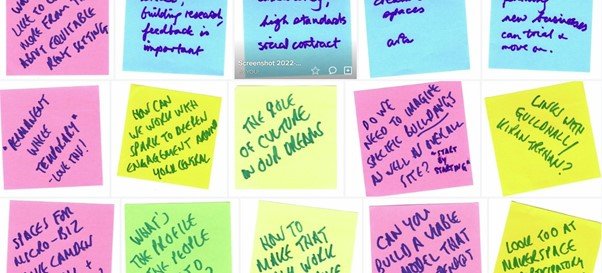Growing a Mixed-Use Neighbourhood
YoCo Workshop Saturday 14th May 2022
How do we start with the local community and expertise from here and elsewhere in the city, and create a place where people really live, work, learn, and play together, and where we make the most of the connections between these varied activities? We explored this, starting with the history of Spark:York CIC from the founders, and considering how “meanwhile use” on the York Central site can be re-thought as an incubator where we sow the seeds for a range of businesses which will drive the local economy as the site develops.
The interview with Spark founders Sam Leach and Tom McKenzie can be watched on YouTube here.
Participants in the event used Post-Its (what else?) to record ideas, comments, questions and quotable quotes, and these can be found on our Flickr archive here.
What were the key issues that came out of the event?
Much of the discussion was around how we could make the earliest possible start to activities on York Central – very much “meanwhile” activities such as planting and food growing on available spaces, and you can see how this progresses from the regular update blogs here, or by taking part in the monthly Open Meetings (details here) and by joining YoCo (details here). So for this blog I’ll focus on the more strategic comments from the Post-Its.
Spark as a short-term place, with a long-term legacy
One of the key bits of feedback about the experience of Spark was that – with it always seen as a short-term venture (albeit it’s been less short term than originally envisaged) – there has always been a focus on a long-term legacy, possibly more so than had it always been seen as long-term in itself. So while the architecture and building fabric is transient – chosen in order to be quickly placed and easily removed and re-used elsewhere – the business model and ethos behind the venture has been around long-term change.
Creating a platform which encourages success but allows for “failure”
Business ideas and start-ups don’t always have a long life – some thrive and grow (and often move on to different premises) and some simply cease. But it’s important to stay close to this threshold in order to test riskier ideas and give them a chance. Two conversations came up on this theme.
Firstly it’s important to have a stable background for incubator activities – Spark has regular hours and clear agreements (albeit ones which provide support in the early days and encouragement to follow ethical business practices). Legal and regulatory requirements are taken seriously – the “dark matter” of contracts etc has to be handled and part of the economic fabric.
Secondly it’s important that the overall vehicle is something which can accommodate business failures; Spark was described as “a platform for interesting things”. With YoCo and York Central there have been many discussions about a framework of Action Research – so that not only is “what happens” important, but also observing, documenting, analysing and learning from what happens. For this to be possible, there needs to be a structure in place, with appropriate partners and resources.
What sort of buildings and spaces allow ideas to grow?
Spark has very consciously set itself up as a cultural space – creating an identity and involved in selling an idea (even if in the early stages “it was hard to talk about what you are when you’re not sure”). The shipping containers are a good usable size and by also providing indoor community and meeting space, plus outside social and event space, a range of uses can be accommodated. Going forward, a variety of options were discussed:-
· Co-working initiatives across a wider range of businesses – makers, hairdressers, creatives.
· Looking at makerspaces – the experience of Participatory City in Barking, and larger makerspaces like social enterprise Bloqs in North London
· …and thinking about how an “enabling body” like Spark or YoCo can work with existing businesses in a neighbourhood in order to create better networks and overall wellbeing.
Yes that’s all very well, but this is YORK
When Spark was proposed, there was outrage in some quarters about the idea of shipping containers – in historic York, this isn’t Hackney, etc. Still today there is probably more comment on the appearance of the place than on the underlying process of business incubation, so it’s interesting to pull apart the process and design, in order to then reconnect them. When Spark started, they had heard that the level of graduate retention (students remaining in the city) was around 8% - pitifully low. York was a place to study but too expensive – and maybe too conservative – to stay and develop business ideas. This statistic is probably better now but there is still great demand for start-up space – Spark gets 2-3 enquiries each week (and it would be good to know the level at other equivalent facilities within the city). If we as a city are to develop employment in higher-skill, higher-pay sectors, then can we rely on inward investment – firms moving into the “Grade A office space” we are told we need to build. If we want community wealth creation, where do those fine-grained economic drivers start?
Someone commented that “if we’re building the future of York, it needs to look like the future” – we should allow space for something different and distinctive. We need to think of building types which allow the activities we want – in terms of their space, the ways in which they connect with their surroundings, and also the ways in which they are provided suit the economy they are helping create – affordability must be considered.
In short, we should acknowledge that we need incubator space for the health of our economy, and we should acknowledge that this may look different.


